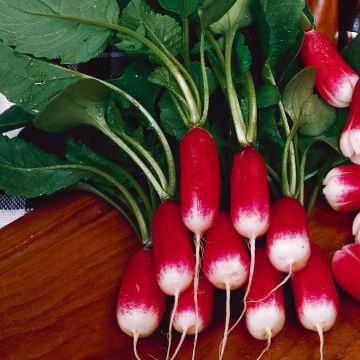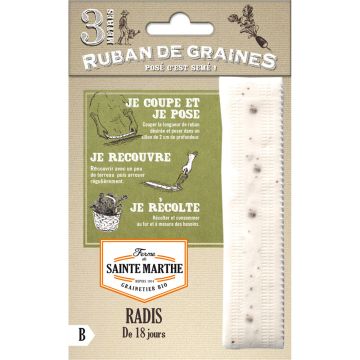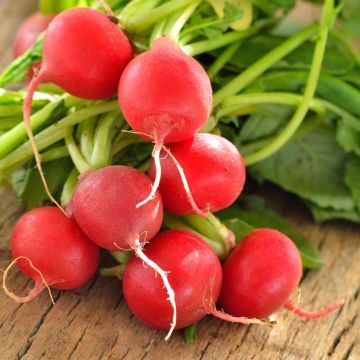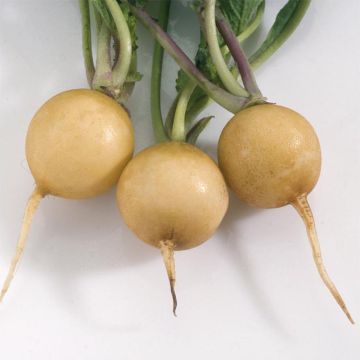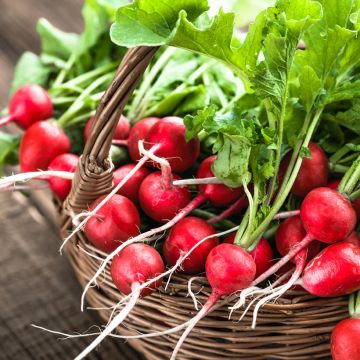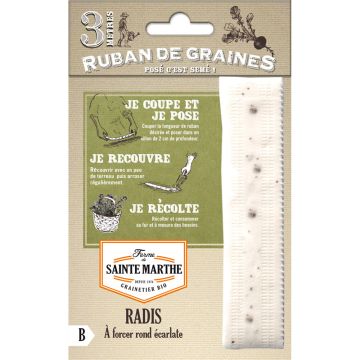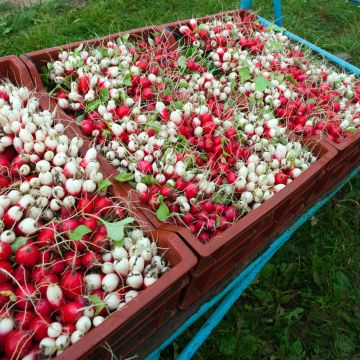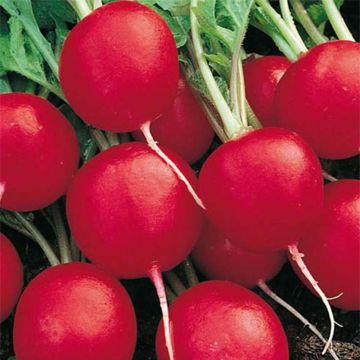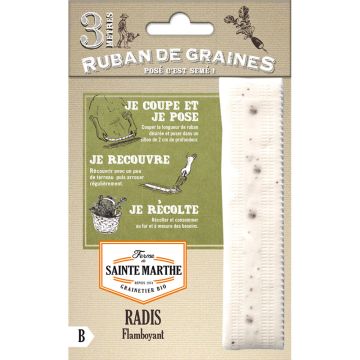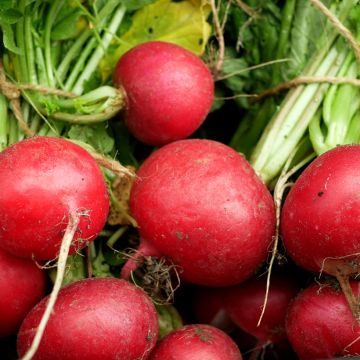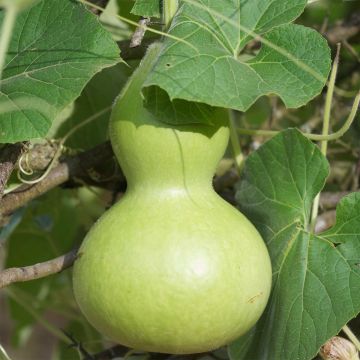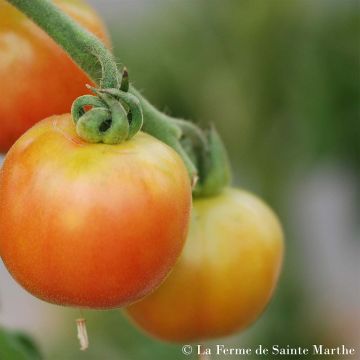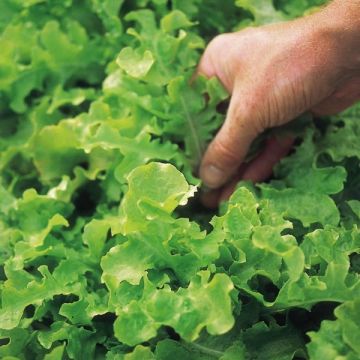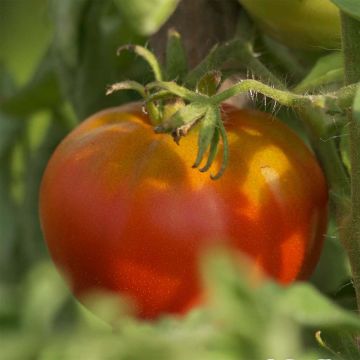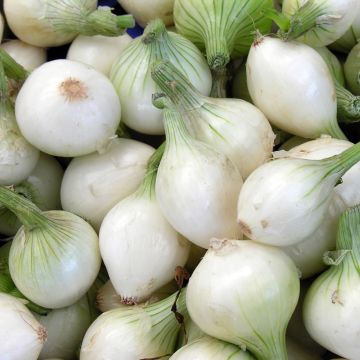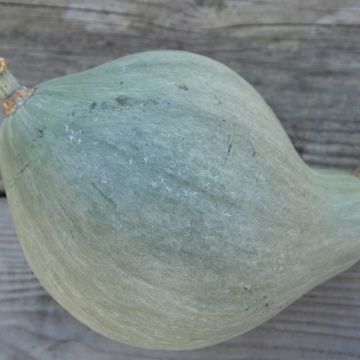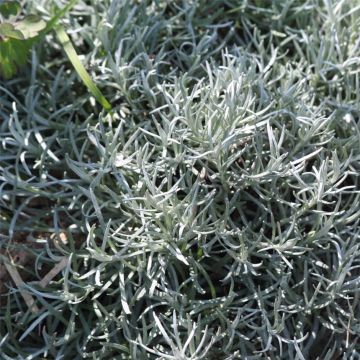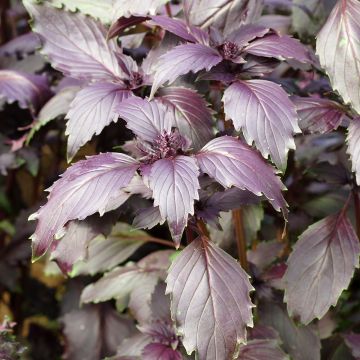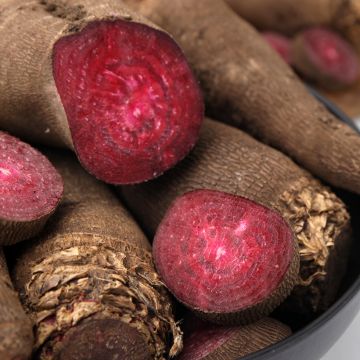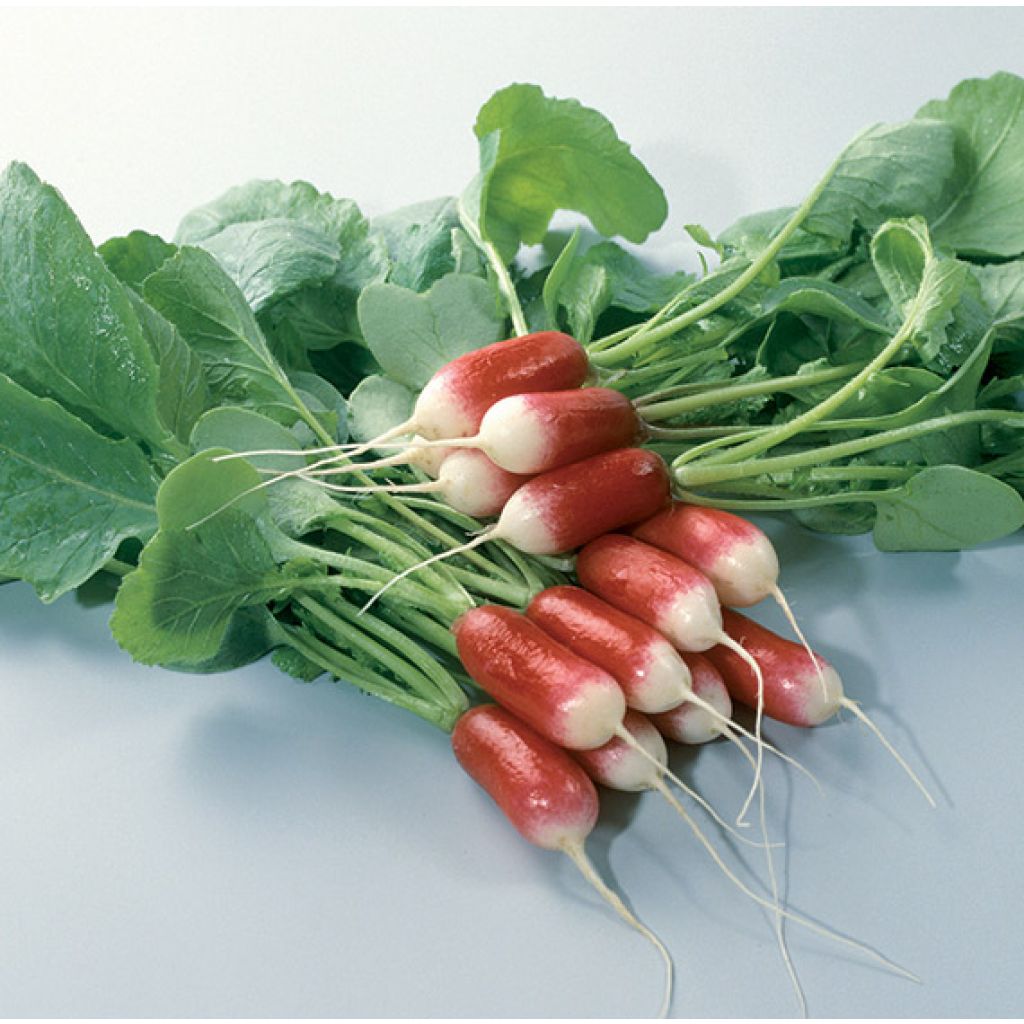

Patricia Organic Radish
Patricia Organic Radish
Raphanus sativus Patricia
Radish, Garden Radish
Radish not grown
Sop, 09/03/2024
This item cannot be shipped to the selected country
Dispatch by letter from €3.90
Delivery to Corse prohibited
More information
Schedule delivery date,
and select date in basket
This plant carries a 6 months recovery warranty
More information
We guarantee the quality of our plants for a full growing cycle, and will replace at our expense any plant that fails to recover under normal climatic and planting conditions.
Seed-only orders are dispatched by sealed envelope. The delivery charge for seed-only orders is €3.90.
Delivery to Corse prohibited: UE law prohibits the import of this plant from mainland France to Corse as part of the fight against Xylella fastidiosa. Please accept our sincere apologies.
More information
Description
The Patricia radish is a variety that can be grown all year round or forced, producing semi-long roots that are bright pink with white tips. It is a classic and highly popular choice, especially for its fast growth.
The radish is a hardy annual or biennial vegetable plant, belonging to the Brassicaceae family. It is mainly consumed for its raw root, but the freshly picked leaves can also be added to soups or broths.
Probably known since the Neolithic era, the radish is believed to originate from the Far East. The name "radis" comes from the Latin word "radix", which simply means "root". Although it was widely consumed by the ancient Egyptians, Romans, and during the Middle Ages, in forms probably different from what we know today, it wasn't until the 16th century that black radishes arrived in France, and the 18th century when black radishes and small red and white radishes started to be consumed.
There are radishes of different colours, with red being the most common, but there are also pink, white, or gray varieties. They are generally classified into 2 main types: monthly radishes, which are represented by small-rooted varieties, and daikon radishes, which have long roots. There are also Japanese radishes, known as "daikon", which have long, white, conical roots and are sometimes sold as turnips.
Winter radishes have large taproots with black, pink, or purple skin. The flesh is white, and the leaves are green and cut, forming a compact tuft at the base of the plant. They have a much stronger taste than monthly radishes. They can be eaten cooked, like turnips, or raw, like carrots.
Winter radishes have many virtues, as they contain vitamin C and sulfur, as well as phosphorus and magnesium. They are anti-scorbutic and diuretic, and are recommended for people with liver and gallbladder problems.
Harvest and Storage
Monthly and summer radishes can be harvested 4 to 6 weeks after sowing. Regular harvesting as soon as the radishes are formed, without letting them grow too large, helps prevent them from becoming hollow and indigestible. Monthly and summer radishes should be consumed quickly. The freshly harvested leaves can be cooked into a delicious soup.
Daikon radishes can be harvested 4 to 5 months after sowing. Gently lift them with a garden fork and let them dry on the ground before bringing them inside. If they stay in the ground over winter, cover the soil with straw.
Gardener's Tips
Sowing radishes and carrots in the same row and at the same time naturally separates the carrot seeds. After harvesting the radishes, there will be space for the carrots to grow.
To have crunchy radishes throughout the season, it is good to spread out the sowings.
Sowing every 2 to 3 weeks ensures a constant supply of perfect radishes to enjoy.
You can also sow your radishes in containers, using potting soil and regular watering.
Report an error about the product description
Harvest
Plant habit
Foliage
Botanical data
Raphanus
sativus
Patricia
Brassicaceae
Radish, Garden Radish
Cultivar or hybrid
Annual
Other Radish seeds
Planting and care
Sowing
Sowing radishes every month is one of the easiest to do. The seeds are sown thinly, directly in place, in loosened soil in rows or broadcasted, barely covering round radish seeds, and 2 cm (0 and 1in) of potting soil or fine soil for half-long radishes. Gently press down with the back of a rake and water with a fine spray. Keep sufficiently moist until germination.
Radishes can be sown all year round with a preference for late winter to early summer, avoiding periods of high heat, and then in late summer to early autumn, when the soil is still warm, before the first frost.
Radishes like bright and sunny locations, and appreciate light shading in the middle of summer. Watering should be light but regular.
Force-sowing radishes
Sowing radishes takes place in place from February, but protection such as a frame or a tunnel should be provided until the end of frost. Sowings are preferably done broadcast for these early radishes.
Sowing monthly radishes and summer radishes
From May, you can sow as you please until the end of summer, or even early autumn if the climate allows, in open ground, in rows spaced 10 to 20 cm (4 to 8in) apart.
Sowing winter radishes
They are sown from June to November, depending on the climate, in open ground, in rows spaced 20 to 30 cm (8 to 12in) apart.
Maintenance
Once the sowing has germinated, thinning is necessary. This operation consists of removing the weaker plants, leaving only the strongest ones at intervals of 4/5 cm (2in) for monthly radishes, and 10 to 15 cm (4 to 6in) for radishes with bulbs.
The soil should be kept relatively moist through regular watering. Hoeing, weeding, and mulching, combined with watering, will help limit the production of pungent radishes. Additionally, preserving moisture will prevent flea beetle invasions, which thrive in hot and dry weather.
Seedlings
Care
Intended location
-
, onOrder confirmed
Reply from on Promesse de fleurs
Vegetable seeds
Haven't found what you were looking for?
Hardiness is the lowest winter temperature a plant can endure without suffering serious damage or even dying. However, hardiness is affected by location (a sheltered area, such as a patio), protection (winter cover) and soil type (hardiness is improved by well-drained soil).

Photo Sharing Terms & Conditions
In order to encourage gardeners to interact and share their experiences, Promesse de fleurs offers various media enabling content to be uploaded onto its Site - in particular via the ‘Photo sharing’ module.
The User agrees to refrain from:
- Posting any content that is illegal, prejudicial, insulting, racist, inciteful to hatred, revisionist, contrary to public decency, that infringes on privacy or on the privacy rights of third parties, in particular the publicity rights of persons and goods, intellectual property rights, or the right to privacy.
- Submitting content on behalf of a third party;
- Impersonate the identity of a third party and/or publish any personal information about a third party;
In general, the User undertakes to refrain from any unethical behaviour.
All Content (in particular text, comments, files, images, photos, videos, creative works, etc.), which may be subject to property or intellectual property rights, image or other private rights, shall remain the property of the User, subject to the limited rights granted by the terms of the licence granted by Promesse de fleurs as stated below. Users are at liberty to publish or not to publish such Content on the Site, notably via the ‘Photo Sharing’ facility, and accept that this Content shall be made public and freely accessible, notably on the Internet.
Users further acknowledge, undertake to have ,and guarantee that they hold all necessary rights and permissions to publish such material on the Site, in particular with regard to the legislation in force pertaining to any privacy, property, intellectual property, image, or contractual rights, or rights of any other nature. By publishing such Content on the Site, Users acknowledge accepting full liability as publishers of the Content within the meaning of the law, and grant Promesse de fleurs, free of charge, an inclusive, worldwide licence for the said Content for the entire duration of its publication, including all reproduction, representation, up/downloading, displaying, performing, transmission, and storage rights.
Users also grant permission for their name to be linked to the Content and accept that this link may not always be made available.
By engaging in posting material, Users consent to their Content becoming automatically accessible on the Internet, in particular on other sites and/or blogs and/or web pages of the Promesse de fleurs site, including in particular social pages and the Promesse de fleurs catalogue.
Users may secure the removal of entrusted content free of charge by issuing a simple request via our contact form.
The flowering period indicated on our website applies to countries and regions located in USDA zone 8 (France, the United Kingdom, Ireland, the Netherlands, etc.)
It will vary according to where you live:
- In zones 9 to 10 (Italy, Spain, Greece, etc.), flowering will occur about 2 to 4 weeks earlier.
- In zones 6 to 7 (Germany, Poland, Slovenia, and lower mountainous regions), flowering will be delayed by 2 to 3 weeks.
- In zone 5 (Central Europe, Scandinavia), blooming will be delayed by 3 to 5 weeks.
In temperate climates, pruning of spring-flowering shrubs (forsythia, spireas, etc.) should be done just after flowering.
Pruning of summer-flowering shrubs (Indian Lilac, Perovskia, etc.) can be done in winter or spring.
In cold regions as well as with frost-sensitive plants, avoid pruning too early when severe frosts may still occur.
The planting period indicated on our website applies to countries and regions located in USDA zone 8 (France, United Kingdom, Ireland, Netherlands).
It will vary according to where you live:
- In Mediterranean zones (Marseille, Madrid, Milan, etc.), autumn and winter are the best planting periods.
- In continental zones (Strasbourg, Munich, Vienna, etc.), delay planting by 2 to 3 weeks in spring and bring it forward by 2 to 4 weeks in autumn.
- In mountainous regions (the Alps, Pyrenees, Carpathians, etc.), it is best to plant in late spring (May-June) or late summer (August-September).
The harvesting period indicated on our website applies to countries and regions in USDA zone 8 (France, England, Ireland, the Netherlands).
In colder areas (Scandinavia, Poland, Austria...) fruit and vegetable harvests are likely to be delayed by 3-4 weeks.
In warmer areas (Italy, Spain, Greece, etc.), harvesting will probably take place earlier, depending on weather conditions.
The sowing periods indicated on our website apply to countries and regions within USDA Zone 8 (France, UK, Ireland, Netherlands).
In colder areas (Scandinavia, Poland, Austria...), delay any outdoor sowing by 3-4 weeks, or sow under glass.
In warmer climes (Italy, Spain, Greece, etc.), bring outdoor sowing forward by a few weeks.

































